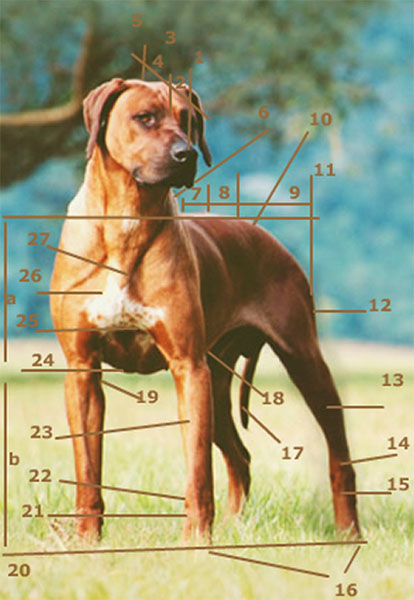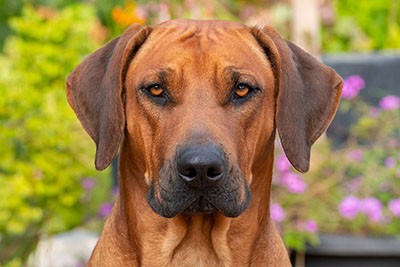Standard of Rhodesian Ridgeback

Legend
1 : Nose
2 : Muzzle
3: Stop
4: Skull
5: Occiput
6 : Withers
7: Back
8: Loin
9: Croup
10: Tail Set
11 : Point of Croup (ischium)
12: Thigh
13: Leg
14: Hock Joint
15: Hock
16: Feet
17: Stifle
18: Bottom Line
19: Elbow
20: Ground
21: Pastern
22: Wrist
23: Arm
24: Chest Level
25: Upper Arm
26: Point of Chest (sternum)
27: Point of Shoulder
a: Chest Depth
b: Height at the Elbow
a+b: Height at the Withers
Head
Cranial Region:
- Skull: Should be of a hair length (width of head between ears, distance from occiput to stop, stop to end of nose, should be equal), flat and broad between the ears; the head should be free from wrinkles when in repose.
- Stop: The stop should be reasonably well defined and not in one straight line from the nose to the occipital bone.
Facil Region:
- Nose: The nose should be black or brown. A black nose should be accompanied by dark eyes, a brown nose by amber eyes.
- Muzzle: The muzzle should be long, deep and powerful.
- Lips: The lips should be clean, closely fitting the jaws.
- Jaws/Teeth: Jaws strong, with a perfect and complete scissor bite, i.e. the upper teeth closely overlapping the lower teeth and set square to the jaws. The teeth must be well developed, especially the canines or holders.
- Cheeks: Cheeks should be clean.
- Eyes: Should be moderately well apart, round, bright and sparkling, with intelligent expression, their colour harmonising with the colour of the coat.
- Ears: Should be set rather high, of medium size, rather wide at base, and gradually tapering to a rounded point. They should be carried close to the head.
- Neck: Should be fairly long, strong and free from throatiness.
Body
- Back: Powerful.
- Loins: Strong, muscular and slightly arched.
- Chest: Should not be too wide, but very deep and capacious; the brisket should reach to the elbow. Forechest should be visible when viewed from the side. Ribs moderately well sprung, never rounded like barrel-hoops.
- Tail: Should be strong at the root and gradually tapering towards the end, free form coarseness. It should be of moderate length. It should not be attached too high nor too low, and should be carried with a slight curve upwards, never curled.
Limbs
- Forequarters: The forelegs should be perfectly straight, strong and well boned, with the elbows close to the body. When viewed from the side, the forelegs should be wider than viewed from the front.
- Shoulders: The shoulders should be sloping, clean and muscular.
- Pastern: Should be strong with light spring.
- Hindquarters: In the hind legs the muscles should be clean and well defined.
- Stifle: Good turn of stifle.
- Hock: Strong, well let down.
- Feet: The feet should be compact and round, with well arched toes and tough, elastic pads, protected by hair between the toes and pads.
- Gait / Movement: Straight forward, free and active.
Coat
- Hair: Should be short and dense, sleek and glossy in appearance, but neither woolly nor silky.
- Colour: Light wheaten to red wheaten. A little white on the chest and toes is permissible, but excessive white hairs here, on belly, or above toes is undesirable. A dark muzzle and ears permissible. Excessive black hairs throughout the coat are highly undesirable.
Size and Weight
- Height at withers:
- Dogs: 63-69 cm (25” -27”).
- Bitches: 61-66 cm (24” -26”).
- Weight:
- Dogs: 36,5 kg-40.5 kg (80 lbs).
- Bitches: 32 kg-38.5 kg (70 lbs).
Faults
Any departure from the foregoing points should be considered a fault and the seriousness with which the fault should be regarded should be in exact proportion to its degree.
N.B.: Male animals should have two apparently normal testicles fully descended into the scrotum.
